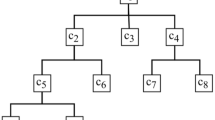Abstract
Similarity Reasoning in the presence of vague information is becoming fundamental in several research areas and, in particular, in the Semantic Web. Fuzzy Formal Concept Analysis (FFCA) is a generalization of Formal Concept Analysis (FCA) for modeling uncertainty information. Although FFCA has become very interesting for supporting different activities for the development of the Semantic Web, in the literature it is usually addressed at a technical level and intended for a restricted audience. This paper proposes a similarity measure for FFCA concepts. The key notions underlying the proposed approach are presented informally, in order to reach a broad audience of readers.



Similar content being viewed by others
References
Ali, R., & Beg, S. (2009). Automatic performance evaluation of web search systems using rough set based rank aggregation. In Proc. of the first int. conf. on Intelligent Human Computer Interaction (IHCI) (pp. 344–358).
Bai, L., & Liu, M. (2008). A fuzzy-set based semantic similarity matching algorithm for web service. In Proc. of the IEEE int. conference on services computing (Vol. 2). IEEE Computer Society.
Belohlávek, R., Outrata, J., & Vychodil, V. (2008). Fast factorization by similarity of fuzzy concept lattices with hedges. International Journal of Foundations of Computer Science, 19(2), 255–269.
Berners-Lee, T., et al. (2001). The semantic web. Scientific American.
Beydoun, G. (2009). Formal concept analysis for an e-learning semantic web. Expert Systems with Applications, 36(8), 10952–10961.
Buche, P., Dibie-Barthlemy, J., Haemmerl, O., & Hignette, G. (2006). Fuzzy semantic tagging and flexible querying of XML documents extracted from the web. Journal of Intelligent Information Systems, 26(1), 25–40.
Castano, S., De Antonellis, V., Fugini, M. G., & Pernici, B. (1998). Conceptual schema analysis: Techniques and applications. ACM Transactions on Database Systems, 23(3), 286–333.
Doherty, P., Grabowski, M., Lukaszewicz, W., & Szalas, A. (2003). Towards a framework for approximate ontologies. Fundamenta Informaticae, 57, 147–165.
Fellbaum, C. (1998). Semantic network of english: The mother of all wordNets. Computers and the Humanities, 32, 209–220.
Formica, A. (2006). Ontology-based concept similarity in formal concept analysis. Information Sciences, 176(18), 2624–2641.
Formica, A. (2008). Concept similarity in formal concept analysis: An information content approach. Knowledge-Based Systems, 21(1), 80–87.
Formica, A. (2010). Concept similarity in fuzzy formal concept analysis for semantic web. International Journal of Uncertainty, Fuzziness And Knowledge-Based Systems, 18(2), 153–167.
Formica, A. (2012). Semantic web search based on rough sets and fuzzy formal concept analysis. Knowledge-Based Systems, 26, 40–47.
Hwang, S., Kim, H., & Yang, H. (2005). A FCA-based ontology construction for the design of class hierarchy. Computational science and its applications (ICCSA), LNCS (Vol. 3842, pp. 827–835).
Jiang, Y., Wang, J., Tang, S., & Xiao, B. (2009). Reasoning with rough description logic: An approximate concepts approach. Information Sciences, 179, 600–612.
Kim, B., & Park, Y. (2001). Web search using dynamic keyword suggestion based on formal concept analysis. In W. Smari (Ed.), Proc. of the ISCA 3rd Int. Conf. on Information Reuse and Integration (IRI) (pp. 108–114). 27–29 November 2001. Las Vegas, Nevada, USA.
Kuhn, H. W. (1955). The Hungarian method for the assignment problem. Naval Research Logistics Quarterly, 2, 83–97.
Lin, D. (1998). An information-theoretic definition of similarity. In Proc. of the int. conference on machine learning (pp. 296–304). Madison: Morgan Kaufmann.
Lukasiewicz, T., & Straccia, U. (2008). Managing uncertainty and vagueness in description logics for the semantic web. Journal of Web Semantics, 6(4), 291–308.
Maarek, Y. S., Berry, D. M., & Kaiser, G. E. (1991). An information retrieval approach for automatically constructing software libraries. IEEE Transactions on Software Engineering, 17(8), 800–813.
Park, S., Suresh, N. C., & Jeong, B. (2008). Sequence-based clustering for web usage mining: A new experimental framework and ANN-enhanced K-means algorithm. Data & Knowledge Engineering, 65(3), 512–543.
Resnik, P. (1995). Using information content to evaluate semantic similarity in a taxonomy. In Proc. of the int. joint conference on artificial intelligence, (pp. 448–453). Montreal: Morgan Kaufmann. Accessed 20–25 August 1995.
Simou, N., Stoilos, G., Tzouvaras, V., Stamou, G. B., & Kollias, S. D. (2008). Storing and querying fuzzy knowledge in the semantic web. ISWC Workshop Uncertainty Reasoning for the Semantic Web (URSW), Karlsruhe, Germany.
Stumme, G., & Maedche, A. (2001). FCA-MERGE: Bottom-up merging of ontologies. In Proc. of International Joint Conference on Artificial Intelligence (IJCAI), (pp. 225–234). Seattle, USA.
Tho, Q. T., Hui, S. C., Cheuk, A., Fong, M., & Cao, T. H. (2006). Automatic fuzzy ontology generation for semantic web. IEEE Transactions on Knowledge and Data Engineering, 18(6), 842–856.
Tversky, A. (1977). Features of similarity. Psychological Review, 84(4), 327–352.
Wang, L., & Liu, X. (2008). A new model of evaluating concept similarity. Knowledge-Based Systems, 21(8), 842–846.
Wille, R. (1982). Restructuring lattice theory: An approach based on hierarchies of concepts. In I. Rival (Ed.), Proc. of ordered sets (pp. 445–470). Dordrecht: Reidel.
WordNet: A lexical database for the English language. http://www.cogsci.princeton.edu/.
Zadeh, L. A. (1965). Fuzzy sets. Information and Control, 8, 338–353.
Zhang, F., Ma, Z. M., Fan, G., & Wang, X. (2010). Automatic fuzzy semantic web ontology learning from fuzzy object-oriented database model. Database and Expert Systems Applications (DEXA), LNCS (Vol. 6261, pp. 16–30).
Zhao, Y., Halang, W., & Wang, X. (2007). Rough ontology mapping in E-business integration. Studies in Computational Intelligence, 37, 75–93.
Author information
Authors and Affiliations
Corresponding author
Rights and permissions
About this article
Cite this article
Formica, A. Similarity reasoning for the semantic web based on fuzzy concept lattices: An informal approach. Inf Syst Front 15, 511–520 (2013). https://doi.org/10.1007/s10796-011-9340-y
Published:
Issue Date:
DOI: https://doi.org/10.1007/s10796-011-9340-y




